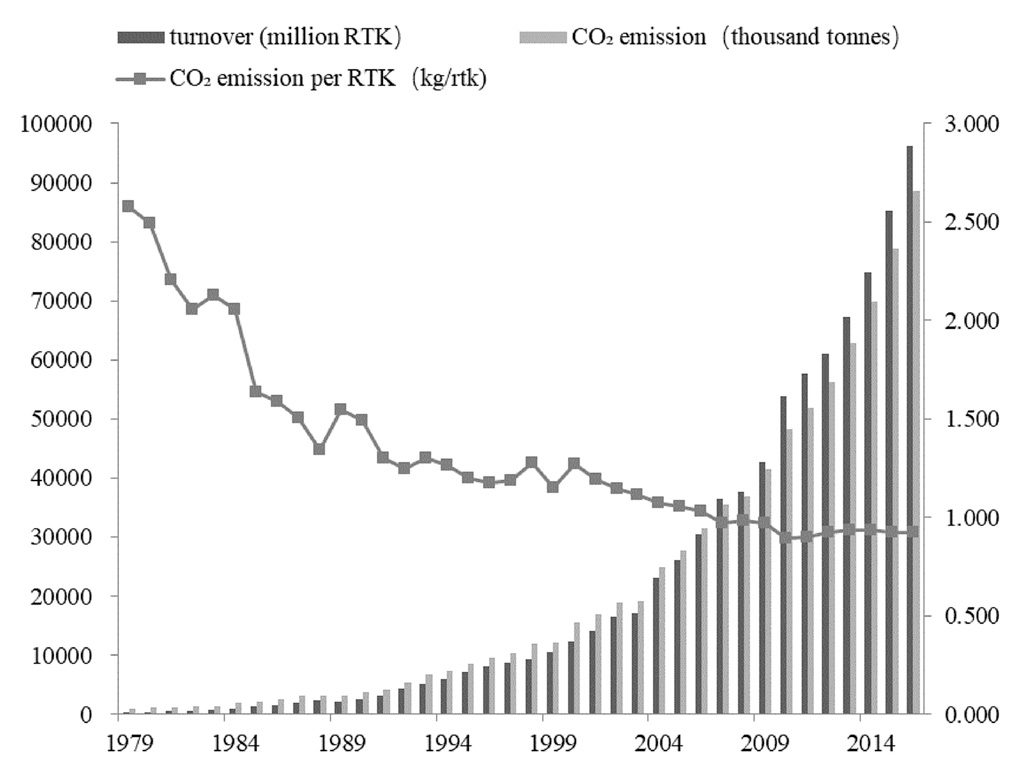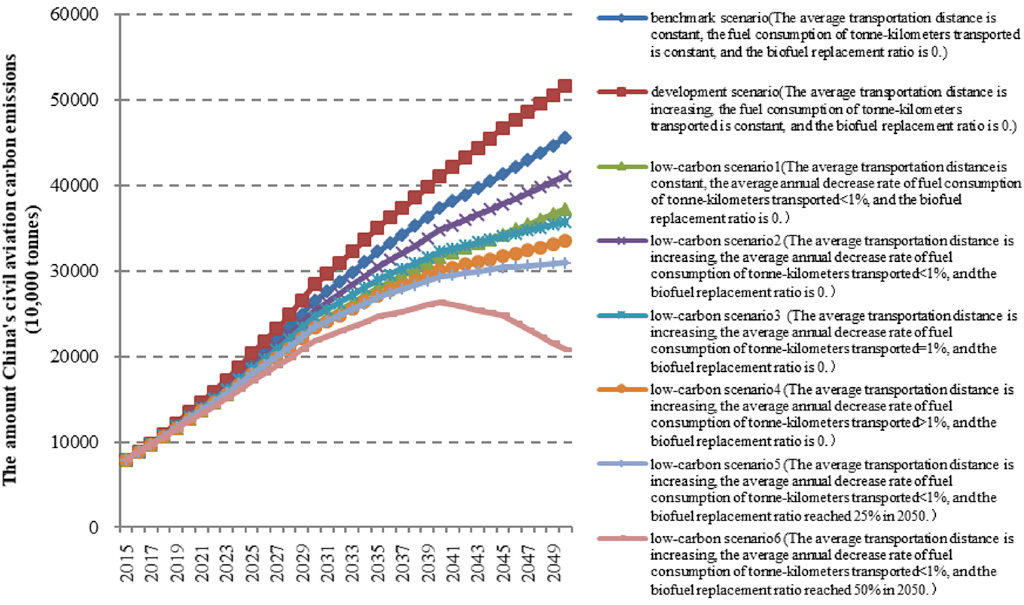
Emissions from Chinese aviation ‘could quadruple by 2050’
Josh Gabbatiss
01.21.20Josh Gabbatiss
21.01.2020 | 4:20pmCarbon emissions from China’s aviation sector could be almost four times higher by the middle of the century, according to new analysis.

With per-capita aviation emissions in China still far below those of nations such as the US and UK, the findings show they have potential for considerable growth in the decades ahead.
Published in the journal Energy Policy, the study comes at a time of mounting concern about the climate impact of aviation, one of the hardest sectors to decarbonise. The authors highlight the lack of prior research into a national sector that has seen demand and emissions soar in recent years.
Amidst talk of electric planes, the growth of the “flight shame” movement and pledges from industry, global emissions from commercial aviation are still expected to roughly triple by 2050.
The global sector is currently responsible for around 2% of emissions, but this share could increase to a quarter if the 1.5C target of the Paris Agreement is met.
With much of the future growth in aviation emissions expected to come from emerging economies in Asia, there is debate around how best to deal with this issue and which nations should shoulder the most responsibility.
Rapid increase
A fast expansion since the 1980s has seen China’s aviation sector rise from being virtually non-existent in the late 20th century to the second largest in the world by 2005.
This trend has accompanied an increase in average wealth, as well as people migrating to urban areas in China. Given the country’s large size, only around 10% (pdf) of flights are international, compared to 84% of European flights. [The area of China is twice that of the EU.]
According to analysis published last year by the International Council on Clean Transportation (ICCT), Chinese flights emitted 95m tonnes of CO2 (MtCO2) in 2018, making up 13% of global aviation emissions. This placed the country second in the emissions ranking, behind the US, on 182MtCO2, and ahead of the UK, on 30MtCO2.
When compared on a per-capita basis, China and other emerging economies are still low in the aviation emissions rankings compared to developed nations. These figures were adjusted for “asymmetric tourist flows” to distinguish between country residents travelling abroad and foreign visitors travelling to that country on the same flight. Source: Analysis by the International Council on Clean Transportation (ICCT). Chart by Carbon Brief using Highcharts.On a per-capita basis, further ICCT analysis shows Chinese emissions are relatively low – just 0.09 tonnes of CO2 compared to 0.57 for the US and 0.86 for the UK.
Nevertheless, according to the new study’s lead author Jinglei Yu and his collaborators at the China Academy of Civil Aviation Science and Technology and Nankai University:
“The rapid increase in [China’s] air transport is expected to continue, which poses critical challenges to this industry in terms of reducing carbon emissions.”
The International Air Transport Association (IATA) predicts that China is due to overtake the US as the world’s largest passenger market by 2029.
However, the authors note in their paper that there has been little research addressing CO2 emissions from Chinese aviation. They set out to assess how much these emissions might increase.
China is the second largest national aviation CO2 emitter and third if the EU is treated as a single entity. Source: Analysis by the International Council on Clean Transportation (ICCT). Chart by Carbon Brief using Highcharts.Different futures
The team found that, by 2016, CO2 emissions from Chinese aviation were 91 times higher than they had been in 1979. They estimated emissions based on consumption of aviation-grade kerosene and concluded the sector would be responsible for 130MtCO2 by 2020.
The necessary data was obtained from the Civil Aviation Administration of China, which records information about all civil aircraft flying domestically and internationally.
To understand changes over the next three decades, they created a model to forecast the long-term carbon emissions, taking into account the growth rate of distances being travelled, fuel consumption and replacement rate of biofuels as fossil-fuel alternatives. They also used a model known as an LMDI (logarithmic mean Divisia index), which is widely used to analyse the main contributing factors to CO2 emissions.
The team then devised eight different scenarios classified as either “benchmark”, “development” or “low-carbon”.

All of the scenarios assume demand for flights China will continue rising significantly in the coming decades and do not consider limitations on demand growth. Government plans, such as the “13th Five-Year Plan for China’s Civil Aviation Development” and industry reports from the likes of Boeing and Airbus, were used as the basis for these different scenarios.
Key to differentiating their scenarios is the uptake of biofuels. The authors note that so far “the alternative fuel factor has not yet played a role in emissions and the future development trend is uncertain”.
Under their “benchmark” scenario, in which demand rises while average distance travelled and fuel efficiency remain constant, and biofuels are not a factor, emissions rise to 456MtCO2 by 2050, 3.5 times higher than in 2020.
For the “development” scenario, in which the average distance travelled by passengers continues to rise, the emissions nearly quadruple to 516MtCO2 by 2050.

However, for the more ambitious low-carbon scenarios in which biofuel replacement reaches 25% or even 50%, this rise is significantly curtailed – to 310 and 208MtCO2, respectively.
Sola Zheng, a researcher at ICCT specialising in Chinese aviation, tells Carbon Brief the numbers “seem realistic”, adding that they are based on “reasonable projections of traffic growth and fuel efficiency improvement”, and chime with growth predicted by the industry. However, she also notes:
“Deployment of aviation biofuel is highly uncertain so there is no good baseline for assessing the scenarios with significant level of biofuel replacement used in this study.”
Growing demand
Apart from the UN International Civil Aviation Organization’s (ICAO) widely cited – although potentially unrealistic – estimate of worldwide aviation emissions tripling by 2050, regional and national projections for emissions growth are thin on the ground.
Figures can also vary based on which flights are being included for each country and often traffic projections are cited instead of emissions.
Despite what Tim Johnson from the Aviation Environment Federation (AEF) describes as this “minefield of partial information”, the figures that are available suggest growth in the aviation sector – and accompanying emissions – will generally be slower in historically richer nations.
An EU report (pdf) from last year predicted CO2 emissions from European aviation will increase by 21% by 2040. Johnson tells Carbon Brief:
“China’s growth is likely to be higher than the global average. The air transport markets in Europe and North America are relatively mature and are forecast to grow at around 4% per annum. China, as the paper notes, has been averaging 13% per annum growth for the last couple of decades and future projections for the Asia-Pacific market show that 7-8% per annum is likely.”
Besides China, both India and Indonesia are predicted by IATA to enter the top five air passenger markets by 2026. Airports Council International has found that “most of the world’s fastest-growing airports” are in emerging markets. (China has plans to increase its number of airports from around 235 today to 450 by 2035.)
While IATA has cited “demand from people in developing economies” as a key factor behind rising future emissions, ICCT’s per-capita analysis shows that people in Australia, North America and Europe are having a disproportionate impact.
Furthermore, Dr Daniel Rutherford from ICCT notes that not only do rich nations, such as the UK and US, host major aerospace manufacturers, they are also “responsible for a disproportionate amount of historical emissions, so it’s reasonable for those countries to take extra and early action to address climate change”.
Finding solutions
The team behind the new paper lay out a few examples of steps that can be taken by China to curb its aviation emissions. These include improvements to fuel efficiency, route optimisation and the development of biofuels.
However, other comentators have argued that such innovations will only make “a small dent” in the gap, adding that widespread electrification of aircraft is unlikely before 2050 and that “sustainable” biofuels remain a long way off.
Growth of the scale expected in China “won’t be compatible with achieving net-zero emissions or limiting global warming to 1.5 or 2C”, Johnson says.
Meanwhile, the UN’s International Civil Aviation Organization (ICAO) has developed its Carbon Offsetting and Reduction Scheme for International Aviation (Corsia), in a bid to achieve “carbon neutral growth”. (See Carbon Brief’s Corsia explainer.)
Rutherford says given its market size, “it’s difficult to see the system working” if China chooses not to participate in Corsia. While the nation initially supported the plan, it subsequently declined to participate in the voluntary pilot phase beginning next year.
In a statement issued by China and Russia ahead of an ICAO meeting at the end of last year, the nations said Corsia “lack[s] moral fairness”:
“Given the difference among countries in development stage, historical responsibility and coping capability, the ‘one-size-fits-all’ approach for Corsia implementation orchestrated by developed countries is a de-facto reversion to the law of the jungle.”
As ICAO exists merely to set standards and cannot enforce them legally, and China may be unwilling to support Corsia, Andrew Murphy from the NGO Transport & Environment, says the world cannot wait for a “top-down” approach to drive down aviation emissions.
“We support a bottom-up approach where wealthier, more ambitious, regions move forward on solutions such as new fuels,” he says.
Yu, J. et al. (2020) China's aircraft-related CO2 emissions: Decomposition analysis, decoupling status, and future trends, Energy Policy, doi.org/10.1016/j.enpol.2019.111215

